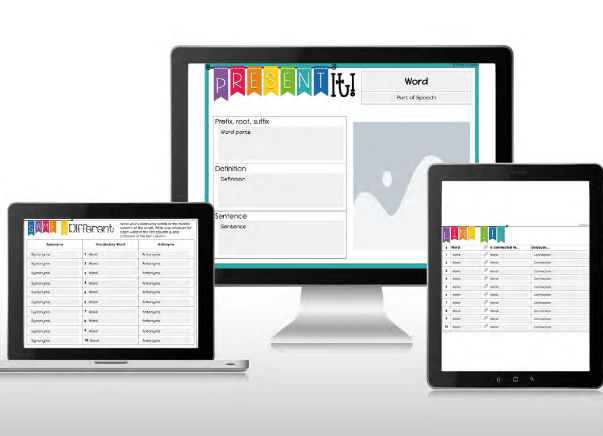
Think about the last time you learned a new word. You had to look up the spelling, figure out how to use it correctly in context and remember the definition for the next time you used it. Students are doing this daily as they learn new words in the classroom and the real word. As they learn dozens of new words, it’s helpful to use vocabulary graphic organizers to keep their thoughts straight.
What type of vocabulary graphic organizer should they use, you may ask? There are so many out there, but I will show you a few of my favorites.

A KWL chart is one of the simplest vocabulary graphic organizers you can use. KWL simply stands for KNOW, WANT TO KNOW, and LEARNED. Teachers use these graphic organizers or charts to break things down for students. As a class, they might brainstorm what the students know about a subject or vocabulary word. It could be that several students “know” the word and definition already.
You could also find that students have lots of questions about the word. These questions get filed under “want to know” on the chart. As you dive into the vocabulary word, do some research and use it more often, students will be able to add items to the “learned” section of the vocabulary graphic organizer. It’s fun to see the progression as students study new words and topics by using this type of organizer.
Another common type of graphic organizer for vocabulary is a word map. Word maps break down all the parts of a word for students to study them further. A word map might include some of the following key elements:
By breaking the word down and finding the elements above, students are able to remember, understand and use their new vocabulary more accurately. Word maps provide a great opportunity for students to do independent or group research as they learn more about their words.
Here is an example of a word map that you can use in your classroom. These word maps are available in this Word Word for Big Kids: Printable Vocabulary Graphic Organizers.
If you use vocabulary words that may have some sort of relation to one another, students can compare and contrast them with an analogy graphic organizer. They can sort their vocabulary words into categories of their choosing and decide on similarities and differences between them. They may also find links between the words and describe those links in an analogy graphic organizer. You can see an example of an analogy graphic organizer below.
You can find this vocabulary graphic organizer on my site.
Students can also organize their thoughts about new vocabulary using flow maps and their own personal dictionaries. Since it can be difficult to organize everything on paper and in bulky binders, students can create their own vocabulary graphic organizers using these Digital Vocabulary Activities & Graphic Organizers. There are 18 activities and variations of graphic organizers to choose from and they are all in digital form, making the easy to use and store. Students can compare similarities and differences between vocabulary words, link them to thoughts and ideas and present them to others. These vocabulary graphics organizers are a great way for students to study the root words, meaning, and other key elements.

Teaching vocabulary can be a tricky task and some teachers don’t feel confident doing it. There’s a tried and true method you can follow to aid in your success as a teacher. Read more about How to Teach Vocabulary in Fun & Effective Ways by clicking on this link.